2016 年浙江宁波大学二外英语考研真题
peers
heated
while
educators
big
another
between
debate
obedient
Western
established
visits
or
contrast
foreigners
assessment
Part I: Cloze Test (30%)
Section A
Directions: Read the passage carefully, fill in each blank with an appropriate word
given below and put your choice in the ANSWER SHEET. (20%)
Which
such
that
advocating
A recent BBC documentary, which filmed an experiment in which five Chinese teachers
taught 50
students according to Chinese-style education norms at a school in the United Kingdom,
has sparked a __1 online debate on whether Chinese or Western methods are better.
But 2 a debate is not new, despite the talk of a cultural clash.
The West has for long promoted small classes 3 focus on students' individuality and
differences, emphasize student-teacher interactions and attach great importance to
cultivating students' independence, creativity and ability to communicate. In 4 ,
classes in China are 5 (that is, they have many students), in which teachers are
the center, and emphasize uniformity, discipline and teachers' authority. Chinese
teaching methods focus on students' diligence, obedience and (for want of a better
term) ability to imitate.
The latest online 6 has again raised the question: Which teaching method is better,
the Chinese or the Western? For long, most Chinese people and 7 have taken it for
granted that the Western education model is superior to the Chinese.
But with the rise of China, especially after Shanghai students' excellent
performance in the Program for International Student Assessment over the past years,
Western governments and 8 have become less certain about the efficacy of their
teaching methods. The fact that students nurtured under the Chinese education model
can be equal to or better than their Western 9 has highlighted the advantages of
the China's education model. In particular, the British secretary of education's
visit to China to review the Chinese teaching methods and some Chinese teachers'
10 to the UK to provide "educational aid" seem to be a shot in the arm for the Chinese
education model.
Many Chinese now believe China's basic education system lays a more solid foundation
for students compared with its 11 counterparts. The main reason for 12 is most of
the Chinese students who go to Western countries for higher education perform
excellently despite having to follow Western curricula, 13 Western students usually
find it difficult to cope with China's teaching methods. Media reports say the BBC
will use a third party to assess how competent students traveling either way are
in mathematics, science, English and Chinese before determining which education
model is more useful for students, the Chinese 14 the Western. But such comparison
and 15 are unscientific.
A country uses a teaching method only as a tool used to realize a specific social
�
purpose, and thus comparisons 16 the Chinese and Western education models are
uncalled for. Before comparing one education model with 17 , researchers and analysts
should consider the different functions different teaching methods are supposed to
perform in their respective social context.
China's education model is more suited to its social demands; the same applies to
the Western model. Despite the Chinese government 18 the cultivation of creative
talents, many Chinese still want people to be obedient to their parents, teachers
and senior officials. As a result, China's educationmodel continues to focus on the
sanctity(尊严)of texts and rules.
In China, students are expected to be observant but 19 . But the Western model focuses
on cultivating students' creativity, and encourages them to criticize 20 views and
defend their stance. As such, both the Chinese and Western education models have
succeeded in developing the qualities in students that suit their social demands.
Therefore, the aim of a comparative study of Chinese and Western education models
should be to promote mutual reference and combine the two into an organic whole that
would benefit both teaching methods.
Section B
Direction: Read the following passage carefully, and fill in each blank with an
appropriate word to achieve cohesion and coherence of the context. (10%)
This year’s UN climate 1 is kicking off right now at the Qatar National Convention
Centre in Doha. It encompasses the 18th Conference of the Parties (COP18) to the
United Nations Framework Convention on Climate Change (UNFCCC) and the 8th Meeting
of the parties to the Kyoto Protocol (CMP8). Over the next two weeks, nearly 200
nations are seeking to extent a flagging UN-led plan to fight 2 change into 2013.
About 17,000 people including delegates and visitors are in attendance, making it
Doha’s largest ever conference. Delegates are looking for a way to extend the Kyoto
Protocol, 3 is the only legally binding U.N. plan for cutting emissions by developed
4 . It’s not going to be an easy task given the global economic slowdown and the
loss of backing from Russia, Japan and Canada. The meeting will also seek to lay
the groundwork for a new pact for 2020. This agreement would bind all nations - not
just the rich - to curb emissions. The effects of climate change are becoming more
apparent than ever, with floods, droughts, heat waves, the melting Arctic ice caps
and rising sea levels.
A U.N. study released last week said that rising greenhouse gas 5 indicated that
global temperatures are on course to 6 between 3 and 5 degrees Celsius. That would
have a catastrophic effect 7 water and food supplies. A UN conference two years ago
saw states agree to try and limit the temperature rises to no more than 2 degrees
Celsius above pre-industrial times. But despite this commitment, greenhouse gas
levels hit record highs in 2011, despite a world economic 8 . For many, the 1997
Kyoto pact still offers the best hope of fighting climate change. It binds developed
nations to cut greenhouse gas emissions to an average 5.2 percent below 1990 levels
____9___ the years 2008 and 2012.
But with many countries reluctant to continue into the second commitment period,
Kyoto backers are down to a core group led by the European Union and Australia.
�
Together, they account for less than 15 percent of world emissions. These countries
say it’s pointless to extend cuts under Kyoto when big emerging nations, led by
China, India, Brazil and South Africa, are under no obligation to curb their
emissions. The United States never ratified (批准)Kyoto, for similar reasons. 10
nations and Kyoto backers say it is vital that the rich countries lead the way towards
a new world-wide accord. That’s due to be negotiated by the end of 2015 and to enter
into force in 2020.
Part II: Reading Comprehension (30%)
Directions: There are 3 passages in this section. Each passage is followed by some
questions or unfinished statements. For each of them there are four choices marked
A,B, C andD. You should decide on the best choice and put it in the Answer Sheet.
Passage One
A quality education is the ultimate liberator. It can free people from poverty,
giving them the power to greatly improve their lives and take a productive place
in society. It can also free communities and countries, allowing them to leap forward
into periods of wealth and social unity that otherwise would not be possible.
For this reason, the international community has committed itself to getting all
the world’s children into primary school by 2015, a commitment known as Education
for All. Can education for all be achieved by 2015? The answer is definitely “yes,”
although it is a difficult task. If we now measure the goal in terms of children
successfully completing a minimum of five years of primary school, instead of just
enrolling for classes, which used to be the measuring stick for education, then the
challenge becomes even more difficult. Only 32 countries were formerly believed to
be at risk of not achieving education for all on the basis of enrollment rates. The
number rises to 88 if completion rates are used as the criterion.
Still, the goal is achievable with the right policies and the right support from
the international community. 59 of the 88 countries at risk can reach universal
primary completion by 2015 if they bring the efficiency and quality of their
education systems into line with standards observed in higher-performing systems.
They also need significant increases in external financing and technical support.
The 29 countries lagging farthest behind will not reach the goal without
unprecedented rates of progress. But this is attainable with creative solutions,
including use of information technologies, flexible and targeted foreign aid, and
fewer people living in poverty.
A key lesson of experience about what makes development effective is that a
country’s capacity touse aid well depends heavily on its policies, institutions
and management. Where a country scores well on these criteria, foreign assistance
can be highly effective.
1. In the first paragraph, the author suggests that a quality education can
_________.
A. free countries from foreign rules B. speed up social progress
C. give people freedom D. liberate people from any exploitation
2. Ideally, the goal of the program of Education for All is to ________ by 2015.
A. get all the world’s children to complete primary school
�
B. enroll all the world’s children into primary school
C. give quality education to people of 88 countries
D. support those committed to transforming their education systems
3. ________ countries are now at risk of not achieving education for all on the basis
of completion rates.
A. 32 B. 59 C. 29 D. 88
4. According to the passage, which of the following is NOT mentioned as the right
policy?
A. Raising the efficiency of education systems.
B. Improving the quality of education.
C. Using information technologies.
D. Building more primary schools.
5. As can be gathered from the last paragraph, foreign aid ________.
A. may not be highly effective
B. is provided only when some criteria are met
C. alone makes development possible
D. is most effective for those countries lagging farthest behind
Passage Two
Although the Constitution organized the American states into what was then the
largest free-trade zone in the world, geographical constraints sorely inhibited
trade and commerce. Enormous physical obstacles and great distances divided the
republic. Henry Adams wrote, “No civilized country had yet been required to deal
with physical difficulties so serious, nor did experience warrant the conviction
that such difficulties could be overcome.” From colonial times to the beginning
of the 19th century, the movement of goods from the places of the production to the
points of sale continued to be a major problem for merchants and consumers alike.
Throughout much of the nation, goods were transported by water from coastal port
to coastal port and along navigable rivers and streams. Some freight moved over
primitive, rutted (有车辙的) roads, but in many areas the absence of roads meant
that commodities could be transported only by pack horse. The cost of shipping items
in such fashion often exceeded their value. Conditions for travelers were equally
as bad. A 5-day trip north from Philadelphia would take a traveler only as far as
Connecticut.
The political and economic leaders of the country recognized the obstacles to
commerce that distance and geographical barriers presented. Entrepreneurs and
politicians proposed many internal development schemes to improve transportation.
In most instances these involved local and state improvements, and the projects
called invariably for the expenditure of substantial amounts of capital.
6. Which statement most accurately relates the main idea of this passage?
A. The U.S. Constitution was responsible for restriction on business during colonial
times.
B. The size and physical nature of the U.S. prevented the expansion of trade and
commerce from colonial times to the early 1800’s.
C. Businessmen and politicians were successful in their attempts to improve
�
transportation.
D. Transportation projects were extremely expensive before 1800.
7. The quote from Henry Adams implies, but does not directly state, that _________.
A. the U.S. was the first civilized country with physical difficulties
B. the Americans believed that they could overcome their physical difficulties
C. many Americans doubted that geographical constraints could be overcome
D. Henry Adams was opposed to the expansion of trade and commerce
8. Which of the following statements is not true?
A. It was more expensive to ship items by water than by land.
B. Shipping items by water was less costly than shipping by land.
C. The cost of shipping items by pack horse was frequently more expensive than the
goods which were being supplied.
D. Pack horses were necessary in areas where there were no roads.
9. Traveling was _________.
A. much easier than shipping B. more difficult than shipping
C. just as difficult as shipping D. necessary if you wanted to buy goods
10. The passage implies, but does not directly state that __________.
A. transportation problem prior to 1800 caused many businessmen to give up
B. improvement of trade and commerce in early U.S. history required hard work and
imagination by entrepreneurs and businessmen
C. small countries have fewer economic problems than big countries
D. big countries with no geographic constraints have few commercial problems
PassageThree
It is natural for young people to be critical of their parents at times and to blame
them for most of the misunderstanding between them. They have always complained,
more or less justly, that their parents are out of touch with modern ways; that they
are possessive and dominant; that they do not trust their children to deal with crisis;
that they talk too much about certain problems; and they have no sense of humor,
at least in parent-child relationships.
I think it is true that parents often underestimate their teenage children and also
forget how they themselves felt when young. Young people often irritate their parents
with choices in clothes and hairstyle, in entertainers and music. This is not their
motive. They feel cut off from the adult world into which they have not yet been
accepted. So they create a culture and society of their own. Then, if it turns out
that their music of entertainers or vocabulary or clothes or hairstyles irritate
their parents, this gives them additional enjoyment. They feel they are superior,
at least in a small way, and that they are leaders in style and taste.
Sometimes you are resistant and proud, because you do not want your parents to approve
of what you do. If they did approve, it looks as if you are the underdog: you can’t
win but at least you can keep your honor. This is a passive way of looking at things.
It is natural enough after long years of childhood, when you were completely under
your parents’ control. But it ignores the fact you are now beginning to be
responsible for yourself.
If you plan to control your life, cooperation can be part of that plan. You can charm
�
others, especially your parents, into doing things the ways you want. You can impress
others with your sense of responsibility and initiative, so that they will give you
the authority to do what you want to do.
11. The author is primarily addressing ________.
A. parents and teachers B. newspaper readers
C. those who give advice to teenagers D. teenagers
12. The first paragraph is mainly about _________.
A. the teenagers’ criticism of their parents
B. misunderstanding between teenagers and their parents
C. the dominance of the parents over their children
D. the teenagers’ ability to deal with crisis
13. Teenagers tend to have strange clothes and hairstyle because they _______.
A. want to show their existence by creating a culture of their own
B. have a strong desire to be leaders in style and taste
C. have no other way to enjoy themselves better
D. want to irritate their parents
14. Teenagers do not want their parents to approve of whatever they do because they
_______. A. have already been accepted into the adult world
B. feel that they are superior in a small way to the adults
C. are not likely to win over the adults
D. have a desire to be independent
15. To improve the parent-child relationships, teenagers are advised to be ________.
A. obedient B. responsible C. cooperative D. independent
Part III. Translation (25%)
Section A
Directions: Translate the following passage into Chinese (15%)
Companies wishing to perform better and cut their risk of bankruptcy should have
more female directors on their board of directors. Women's abilities to make fair
decisions when competing interests are at stake make them better corporate leaders,
researchers have found.
A survey of more than 600 board directors showed that women are more likely to
consider the rights of others and take a cooperative approach to decision-making.
This approach translates into better performance for their companies. The study,
published this week in the International Journal of Business Governance and Ethics,
also found that male directors prefer to make decisions using rules, regulations
and traditional ways of doing business. Female directors, on the other hand, are
less constrained by these parameters and more prepared to use initiative than male
colleagues.
In addition, female directors - who, globally, make up around nine percent of
corporate boards – are significantly more inclined to make decisions by taking the
interests of multiple stakeholders into account in order to arrive at a fair decision.
They also tend to use cooperation, collaboration and consensus-building more often
- and more effectively - in order to make sound decisions. The findings show that
having women on the board is no longer just the right thing but also the smart thing
�
to do. Companies with few female directors may actually be shortchanging their
investors.
Section B
Directions: Translate the following Chinese text into English (10%)
一项研究发现,晚婚在财政上对女性有利,但对男性却不利。
美国弗吉尼亚大学发布了一篇研究报告称,受过大学教育的女性如果在三十多岁时结婚,收
入平均比那些在二十多岁时就结婚的女性高出 56%。与此相反,二十多岁就结婚的男性比那
些到三十岁后才结婚的男性收入更高,无论受教育程度如何。
研究指出,美国人平均结婚年龄达到了史上最高——女性 27 岁,男性 29 岁。相比之下,
199 年的平均结婚年龄为女性 23 岁,男性 26 岁。尽管女性确实能从晚婚中得到经济利益,
但早婚的男性通常日后会更成功。
Part IV. Writing (15%)
Directions: Write an essay of around 160 words based on the following cartoon about
Care for the Elders In your essay, you should describe the picture briefly; explain
its intended meaning;
and give your comments.
�
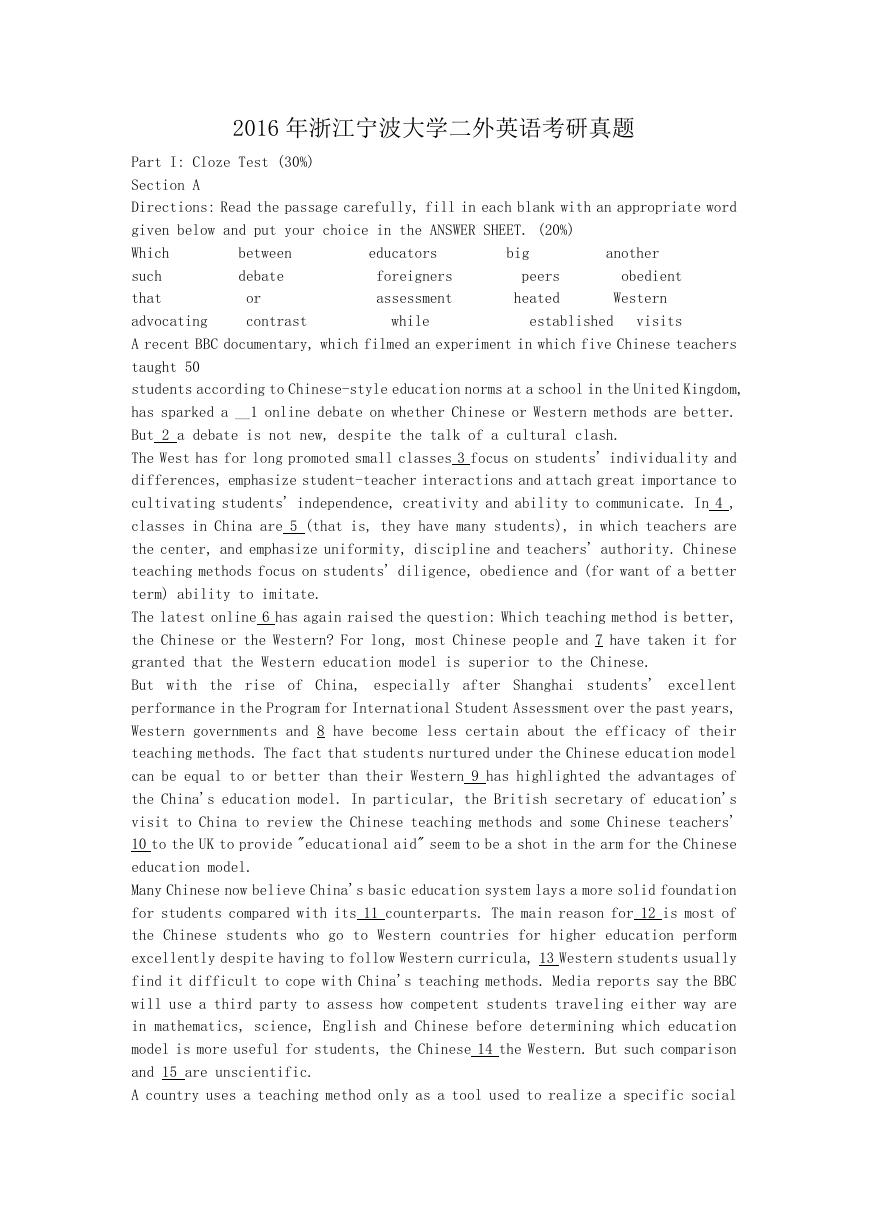

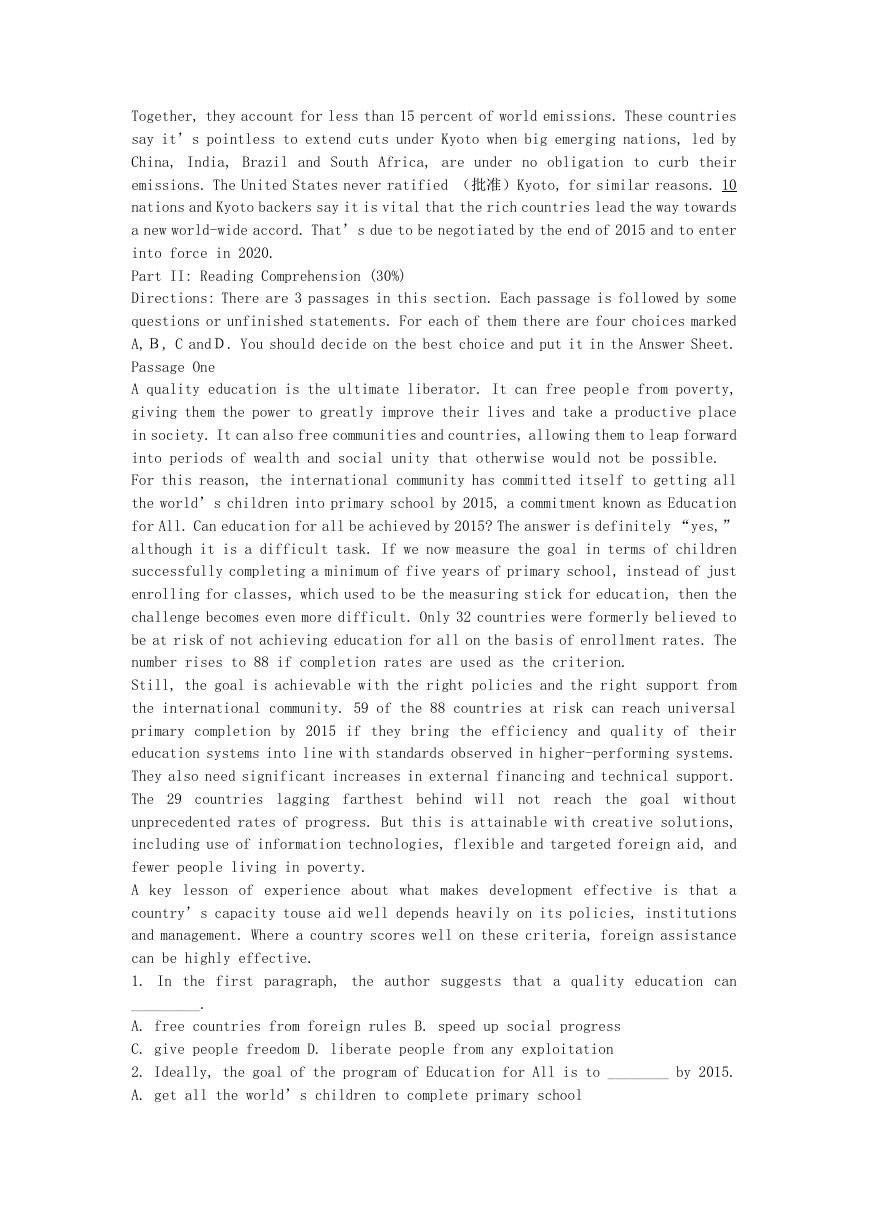
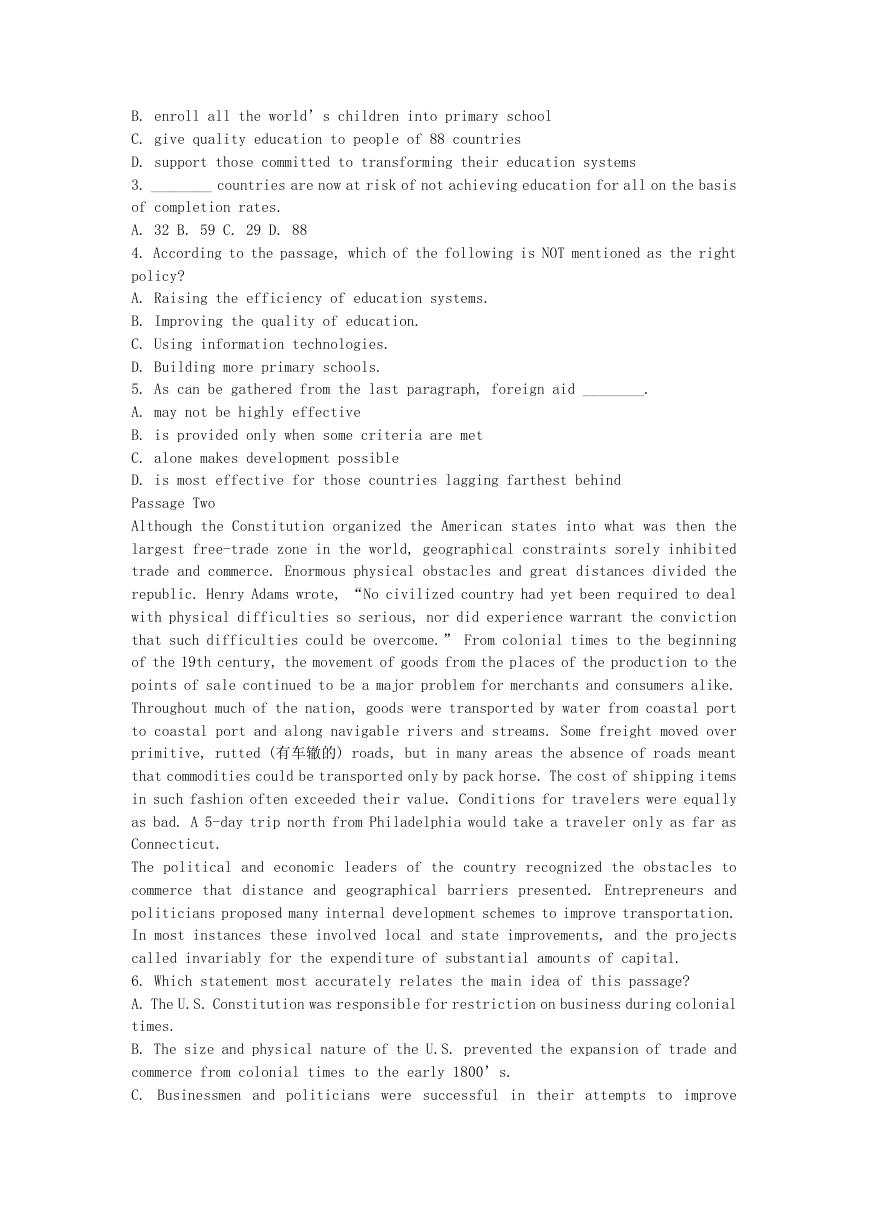
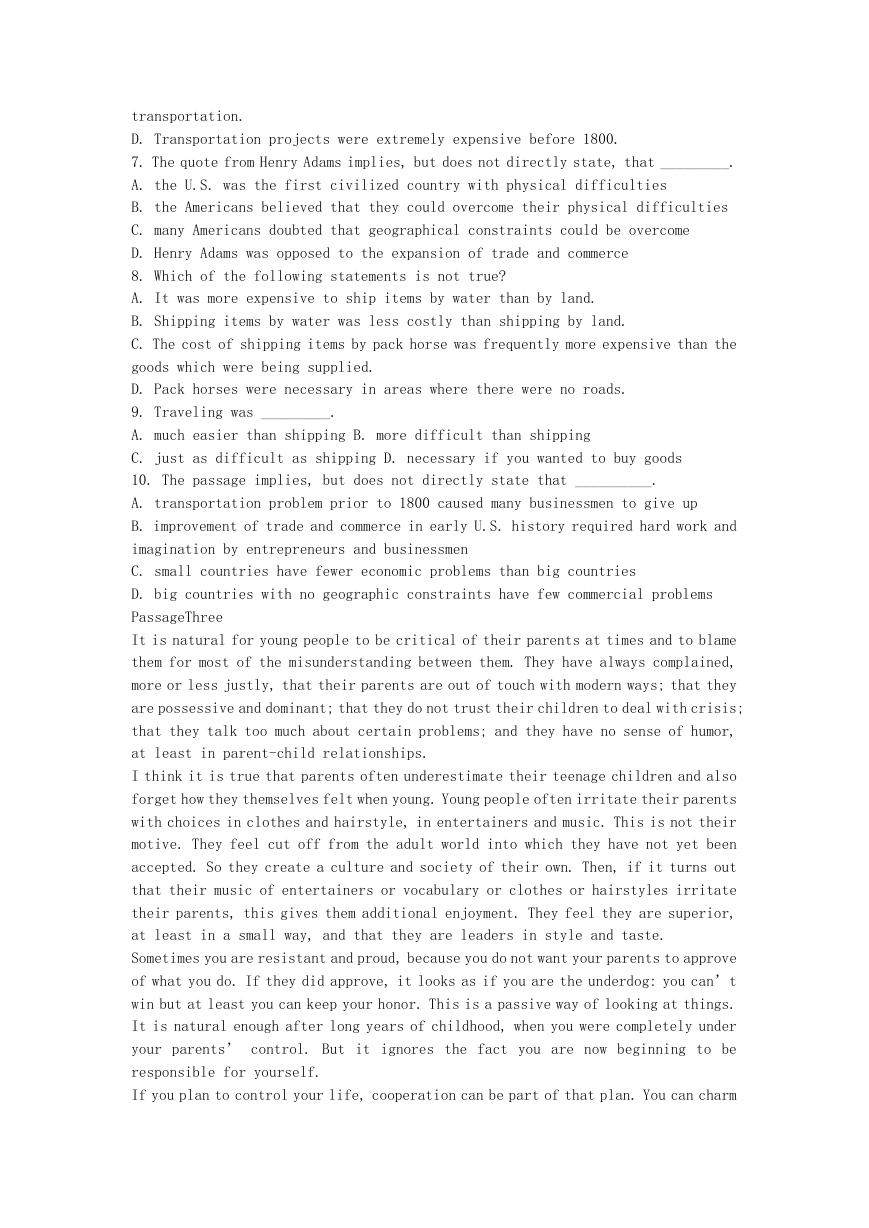

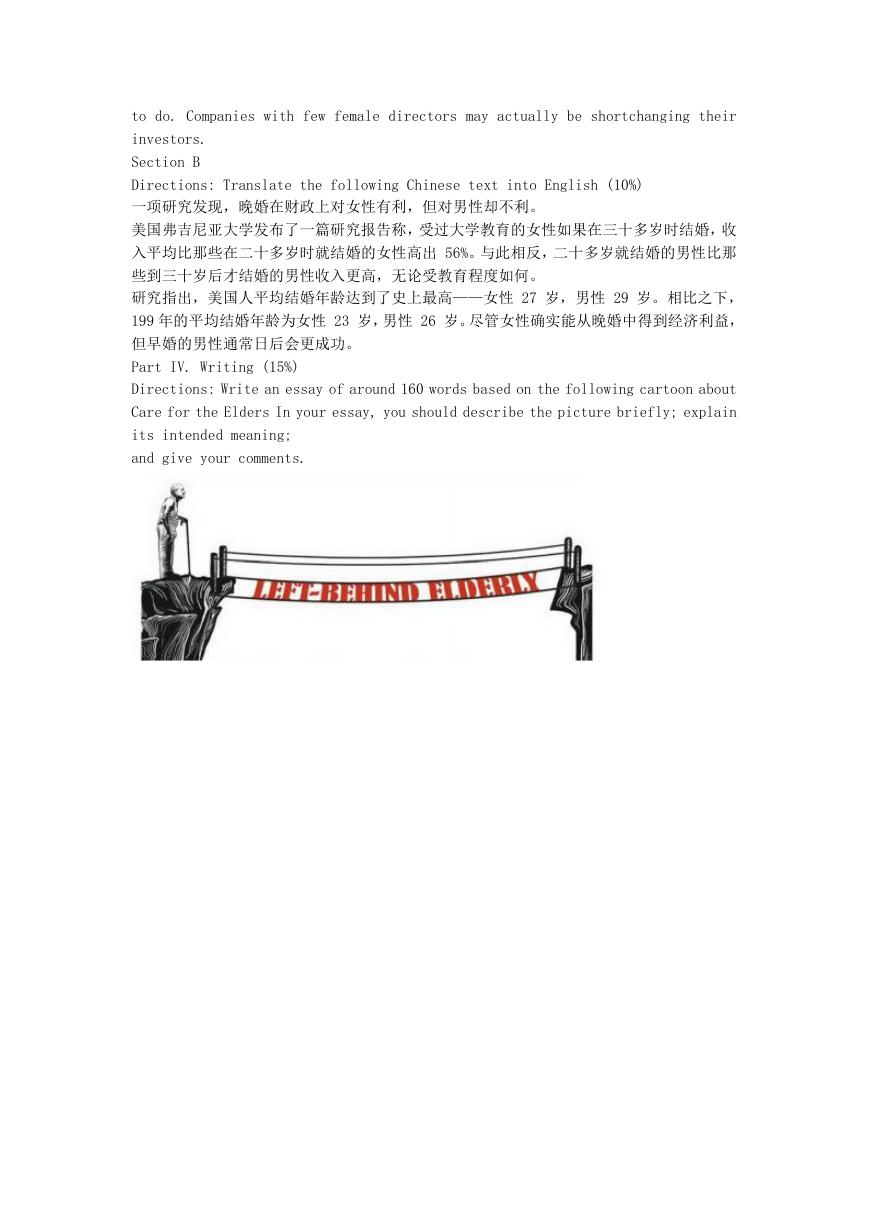







 2023年江西萍乡中考道德与法治真题及答案.doc
2023年江西萍乡中考道德与法治真题及答案.doc 2012年重庆南川中考生物真题及答案.doc
2012年重庆南川中考生物真题及答案.doc 2013年江西师范大学地理学综合及文艺理论基础考研真题.doc
2013年江西师范大学地理学综合及文艺理论基础考研真题.doc 2020年四川甘孜小升初语文真题及答案I卷.doc
2020年四川甘孜小升初语文真题及答案I卷.doc 2020年注册岩土工程师专业基础考试真题及答案.doc
2020年注册岩土工程师专业基础考试真题及答案.doc 2023-2024学年福建省厦门市九年级上学期数学月考试题及答案.doc
2023-2024学年福建省厦门市九年级上学期数学月考试题及答案.doc 2021-2022学年辽宁省沈阳市大东区九年级上学期语文期末试题及答案.doc
2021-2022学年辽宁省沈阳市大东区九年级上学期语文期末试题及答案.doc 2022-2023学年北京东城区初三第一学期物理期末试卷及答案.doc
2022-2023学年北京东城区初三第一学期物理期末试卷及答案.doc 2018上半年江西教师资格初中地理学科知识与教学能力真题及答案.doc
2018上半年江西教师资格初中地理学科知识与教学能力真题及答案.doc 2012年河北国家公务员申论考试真题及答案-省级.doc
2012年河北国家公务员申论考试真题及答案-省级.doc 2020-2021学年江苏省扬州市江都区邵樊片九年级上学期数学第一次质量检测试题及答案.doc
2020-2021学年江苏省扬州市江都区邵樊片九年级上学期数学第一次质量检测试题及答案.doc 2022下半年黑龙江教师资格证中学综合素质真题及答案.doc
2022下半年黑龙江教师资格证中学综合素质真题及答案.doc